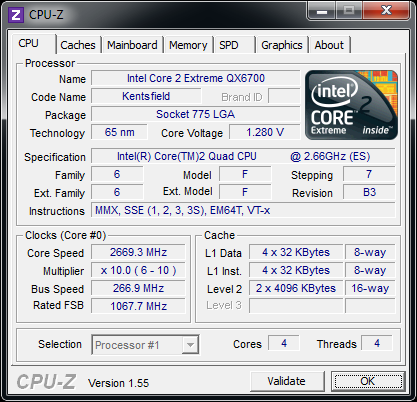Time To Upgrade: Should You Dump Your 2007 PC?
Intel agressively promotes its Core i3/i5/i7 series, but we wonder: Does it make sense to replace a three-year old high-end PC? In the end, quad-core processors were already pretty powerful in 2007. We created a brand new system and a 2007 PC to compare.
2007 Components: Core 2 QX6700, GeForce 8800GTS, WD Raptor
CPU: Core 2 Extreme QX6700 (2.66 GHz Quad Core)
Intel launched its Core 2 Duo processor in 2006 and followed up with Core 2 Quad shortly thereafter. We decided to include a quad-core processor to be able to check just how much better today’s four-core Core i7-870 performs. We did not have a mainstream Core 2 Quad Q6000-series chip, but the Core 2 Extreme QX6700. Although this was a $999 part, it was actually replaced by the Core 2 Quad Q6700 later on, which had exactly the same cache capcities and clock speeds. The only real difference was the thermal envelope, which was moved from 130 W in the case of the Core 2 Extreme QX6700 to 105 W on the Core 2 Quad Q6700. This was made possible by the G0 stepping that replaced B3 (which we use here).
This Kentsfield-based quad-core processor utilizes two 65 nm Conroe dies in one processor package. Each of the dies has a total of 4 MB L2 cache that is used by its two cores. Both dies run at 2.66 GHz and communicate over the front side bus. This has always been a reason for criticism, though it was alleviated by Core i7's monolithic construction.
Graphics: Zotac GeForce 8800 GTS
Our graphics card of choice is a GeForce 8800 GTS that is based on Nvidia’s G80 GPU with 20 ROPs and 96 stream processors. This card has 320 MB of GDDR3 video memory and was an upper-mainstream solution in 2007. It comsumes roughly 60 W at idle and a bit less than 140 W under full 3D load, which is a higher idle power requirement than you’d see on today’s upper mainstream graphics cards, while the peak power consumption is somewhat similar.
The GeForce 8-series was the first graphics family line that was based on Shader Model (SM) 4.0 and that came with DirectX 10 support.
Storage: Western Digital WD1500 Raptor
Get Tom's Hardware's best news and in-depth reviews, straight to your inbox.
WD’s Raptor is one of the most popular hard drives among enthusiasts. The initial models had 36 and 74 GB and the third generation went up to 150 GB. The Raptor and the newer VelociRaptor drives are the only desktop hard drives with Serial ATA interfaces that work at a 10 000 RPM spindle speed, providing excellent access times and very robust throughput along with adequate capacities. Today’s VelociRaptor drives are based on the 2.5” form factor and are much faster. In addition, even a 7200 RPM hard drive delivers clearly more throughput than the WD1500 Raptor, but overall performance is still above average.
Current page: 2007 Components: Core 2 QX6700, GeForce 8800GTS, WD Raptor
Prev Page The 2007 System: Intel P35 Express Next Page The 2010 System: Intel P55 Express

